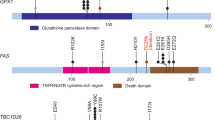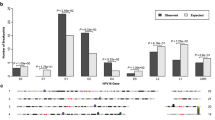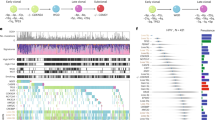Abstract
Genetic changes orchestrated by human papillomaviruses are the most important known factors in carcinogenesis of the uterine cervix. However, it is clear that additional genetic events are necessary for tumour progression. We have used comparative genomic hybridization to document non-random chromosomal gains and losses within a subset of 37 cervical carcinomas matched for clinical stage Ib, but with different lymph node status. There were significantly more chromosomal changes in the primary tumours when the lymph nodes were positive for metastases. The most frequent copy number alterations were loss of 3p, 11q, 6q and 10q and gain of 3q. The smallest areas of loss and gain on chromosome 3 were 3p14–22 and 3q24–26. The study identifies progressive DNA copy number changes associated with early-stage invasive cervical cancers with and without lymph node metastases, a factor of potential prognostic and therapeutic value. © 2000 Cancer Research Campaign http://www.bjcancer.com
Similar content being viewed by others
Article PDF
Change history
16 November 2011
This paper was modified 12 months after initial publication to switch to Creative Commons licence terms, as noted at publication
References
Aubele M, Zitzelsberger H, Schenck U, Walch A, Hofler H and Werner M (1998) Distinct cytogenetic alterations in squamous intraepithelial lesions of the cervix revealed by laser-assisted microdissection and comparative genomic hybridization. Cancer 84: 375–379
Bauer HM, Ting Y, Greer CE, Chambers JC, Tashiro CJ, Chimera J, Reingold A and Manos MM (1991) Genital human papillomavirus infection in female university students as determined by a PCR-based method [see comments]. Jama 265: 472–477
Dellas A, Torhorst J, Jiang F, Proffitt J, Schultheiss E, Holzgreve W, Sauter G, Mihatsch MJ and Moch H (1999) Prognostic value of genomic alterations in invasive cervical squamous cell carcinoma of clinical stage IB detected by comparative genomic hybridization. Cancer Res 59: 3475–3479
Durst M, Dzarlieva-Petrusevska RT, Boukamp P, Fusenig NE and Gissmann L (1987) Molecular and cytogenetic analysis of immortalized human primary keratinocytes obtained after transfection with human papillomavirus type 16 DNA. Oncogene 1: 251–6
Hampton GM, Penny LA, Baergen RN, Larson A, Brewer C, Liao S, Busby-Earle RM, Williams AW, Steel CM and Bird CC (1994) Loss of heterozygosity in cervical carcinoma: subchromosomal localization of a putative tumor-suppressor gene to chromosome 11q22–q24. Proc Natl Acad Sci USA 91: 6953–6957
Heselmeyer K, Schrock E, du Manoir S, Blegen H, Shah K, Steinbeck R, Auer G and Ried T (1996) Gain of chromosome 3q defines the transition from severe dysplasia to invasive carcinoma of the uterine cervix. Proc Natl Acad Sci USA 93: 479–484
Heselmeyer K, Macville M, Schrock E, Blegen H, Hellstrom AC, Shah K, Auer G and Ried T (1997) Advanced-stage cervical carcinomas are defined by a recurrent pattern of chromosomal aberrations revealing high genetic instability and a consistent gain of chromosome arm 3q. Genes Chromosomes Cancer 19: 233–240
Isola JJ, Kallioniemi OP, Chu LW, Fuqua SA, Hilsenbeck SG, Osborne CK and Waldman FM (1995) Genetic aberrations detected by comparative genomic hybridization predict outcome in node-negative breast cancer. Am J Pathol 147: 905–911
Kersemaekers AM, Hermans J, Fleuren GJ and van de Vijver MJ (1998) Loss of heterozygosity for defined regions on chromosomes 3, 11 and 17 in carcinomas of the uterine cervix. Br J Cancer 77: 192–200
Kirchhoff M, Rose H, Petersen B, Maahr J, Gerdes T, Lundsteen C, Bryndorf T, Kryger-Baggesen N, Christensen L, Engelholm S and Philip J (1999) Comparative genomic hybridization reveals a recurrent pattern of chromosomal aberrations in severe dysplasia/carcinoma in situ of the cervix and in advanced-stage cervical carcinoma. Genes, Chromosomes Cancer 24: 144–150
Kuukasjarvi T, Tanner M, Pennanen S, Karhu R, Visakorpi T and Isola J (1997) Optimizing DOP-PCR for universal amplification of small DNA samples in comparative genomic hybridization. Genes Chromosomes Cancer 18: 94–101
Larson AA, Liao SY, Stanbridge EJ, Cavenee WK and Hampton GM (1997) Genetic alterations accumulate during cervical tumorigenesis and indicate a common origin for multifocal lesions. Cancer Res 57: 4171–4176
Leyton-Henry J, Scurry JS, Planner RS, Allen D, Sykes P, Garland SM, Borg AJ and Tabrizi SN (1996) Cervical adenoid basal carcinoma, five cases and literature review. International Journal of Gynecologic Cancer 6: 193–199
Liaw KL, Glass AG, Manos MM, Greer CE, Scott DR, Sherman M, Burk RD, Kurman RJ, Wacholder S, Rush BB, Cadell DM, Lawler P, Tabor D and Schiffman M (1999) Detection of human papillomavirus DNA in cytologically normal women and subsequent cervical squamous intraepithelial lesions. J Natl Cancer Inst 91: 954–960
Manos MMTY, Wright DK, Lewis AJ, Broker TR and Wolinsky SM (1989) The use of polymerase chain reaction amplification for the detection of genital human papillomaviruses. Cancer Cells 7: 209–214
Martinbeau P, Kjorstad K and Iversen T (1982) Stage Ib carcinoma of the cervix: the Norwegian Radium Hospital. II. Results when pelvic nodes are involved. Obstet Gynecol 60: 215
Moch H, Presti JC, Jr, Sauter G, Buchholz N, Jordan P, Mihatsch MJ and Waldman FM (1996) Genetic aberrations detected by comparative genomic hybridization are associated with clinical outcome in renal cell carcinoma. Cancer Res 56: 27–30
Resnick RM, Cornelissen MT, Wright DK, Eichinger GH, Fox HS, ter Schegget J and Manos MM (1990) Detection and typing of human papillomavirus in archival cervical cancer specimens by DNA amplification with consensus primers. J Natl Cancer Inst 82: 1477–1484
Ried T, Petersen I, Holtgreve-Grez H, Speicher MR, Schrock E, du Manoir S and Cremer T (1994) Mapping of multiple DNA gains and losses in primary small cell lung carcinomas by comparative genomic hybridization. Cancer Res 54: 1801–1806
Ried T, Just KE, Holtgreve-Grez H, du Manoir S, Speicher MR, Schrock E, Latham C, Blegen H, Zetterberg A and Cremer T (1995) Comparative genomic hybridization of formalin-fixed, paraffin-embedded breast tumors reveals different patterns of chromosomal gains and losses in fibroadenomas and diploid and aneuploid carcinomas. Cancer Res 55: 5415–5423
Schrock E, Thiel G, Lozanova T, du Manoir S, Meffert MC, Jauch A, Speicher MR, Nurnberg P, Vogel S and Janisch W (1994) Comparative genomic hybridization of human malignant gliomas reveals multiple amplification sites and nonrandom chromosomal gains and losses. Am J Pathol 144: 1203–1218
Steenbergen RD, Hermsen MA, Walboomers JM, Meijer GA, Baak JP, Meijer CJ and Snijders PJ (1998) Non-random allelic losses at 3p, 11p and 13q during HPV-mediated immortalization and concomitant loss of terminal differentiation of human keratinocytes. Int J Cancer 76: 412–417
Tanaka H, Shimizu M, Horikawa I, Kugoh H, Yokota J, Barrett JC and Oshimura M (1998) Evidence for a putative telomerase repressor gene in the 3p14.2–p21.1 region. Genes Chromosomes Cancer 23: 123–133
Telenius H, Carter NP, Bebb CE, Nordenskjold M, Ponder BA and Tunnacliffe A (1992) Degenerate oligonucleotide-primed PCR: general amplification of target DNA by a single degenerate primer. Genomics 13: 718–725
Wistuba II, Montellano FD, Milchgrub S, Virmani AK, Behrens C, Chen H, Ahmadian M, Nowak JA, Muller C, Minna JD and Gazdar AF (1997) Deletions of chromosome 3p are frequent and early events in the pathogenesis of uterine cervical carcinoma. Cancer Res 57: 3154–8
zur Hausen H (1976) Condyloma acuminata and human genital cancer. Cancer Research 36: 530
Author information
Authors and Affiliations
Rights and permissions
From twelve months after its original publication, this work is licensed under the Creative Commons Attribution-NonCommercial-Share Alike 3.0 Unported License. To view a copy of this license, visit http://creativecommons.org/licenses/by-nc-sa/3.0/
About this article
Cite this article
Allen, D., White, D., Hutchins, AM. et al. Progressive genetic aberrations detected by comparative genomic hybridization in squamous cell cervical cancer. Br J Cancer 83, 1659–1663 (2000). https://doi.org/10.1054/bjoc.2000.1509
Received:
Revised:
Accepted:
Published:
Issue date:
DOI: https://doi.org/10.1054/bjoc.2000.1509
Keywords
This article is cited by
-
Human papillomavirus and cervical cancer: an insight highlighting pathogenesis and targeting strategies
VirusDisease (2022)
-
Let’s talk about Secs: Sec61, Sec62 and Sec63 in signal transduction, oncology and personalized medicine
Signal Transduction and Targeted Therapy (2017)
-
Identification of SEC62 as a potential marker for 3q amplification and cellular migration in dysplastic cervical lesions
BMC Cancer (2016)
-
HPV type-related chromosomal profiles in high-grade cervical intraepithelial neoplasia
BMC Cancer (2012)
-
Intra-tumour genetic heterogeneity and poor chemoradiotherapy response in cervical cancer
British Journal of Cancer (2011)



